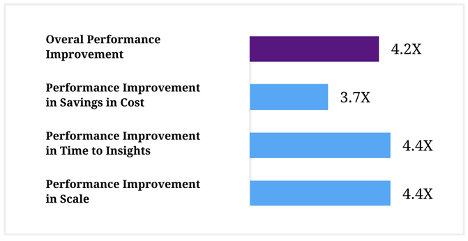There’s been plenty of discuss semantic layers these days. I’ve seen dozens of firms utilizing a semantic layer to drive self-service analytics at scale. However even with all these success tales, I nonetheless get this query: “Is a semantic layer definitely worth the effort?” In different phrases, is the juice definitely worth the squeeze?
So, how are you aware that you simply want a semantic layer? DBP Institute, a knowledge and analytics analysis agency, carried out a survey of knowledge leaders and requested them the identical query. Within the report The Enterprise Affect of Utilizing a Semantic Layer for AI and BI, DBP Institute quantifies the enterprise influence of utilizing a semantic layer for an organization’s enterprise intelligence (BI) and synthetic intelligence (AI) initiatives.
The outcomes of the examine are spectacular, as you’ll be able to see within the chart beneath:

On this article, we are going to dive into some key takeaways that present how a semantic layer can dramatically enhance the pace and scale of analytics supply whereas considerably decreasing the prices.
Velocity
Because the starting of the info age, evidently expertise and information organizations can by no means sustain with the info calls for of the enterprise. A semantic layer delivers analytics to the enterprise sooner, within the following methods:
1. Accelerating Time to Insights
A semantic layer reduces time to insights by connecting analytics shoppers immediately to business-friendly, analysis-ready information. By bringing “stay” information to customers, of their most popular tooling and with out information extracts or imports, there’s no time wasted shifting or reformatting information for evaluation.
2. Accelerating Knowledge Preparation Time
A semantic layer reduces or eliminates many information preparation duties by leveraging information virtualization for transformations. By avoiding bodily information transformation utilizing ETL or ELT instruments, a semantic layer can create new calculations and clear information with out the necessity to bodily persist these transformations.
3. Accelerating Knowledge Modeling
Right now, we require finish customers to mannequin information of their consumption instruments earlier than they’ll create their charts, tables, predictive fashions or just analyze their information. With a semantic layer, information stewards create the semantic mannequin on behalf of knowledge shoppers in order that finish customers can get proper to the enterprise at hand: creating information merchandise.
Scale
Delivering analytics to the enterprise sooner is crucial, however true information democratization requires scale. A semantic layer could make extra information out there to extra individuals within the following methods.
1. Increasing self-service
The wide-scale adoption of “self-service” visualization instruments delivered many positives by releasing customers from the ties of IT. Nevertheless, in doing so, fashionable visualization instruments like Tableau and Energy BI now require their customers to change into information specialists and SQL jockeys – creating “haves” and “have nots” in analytics. A semantic layer makes information accessible to everybody by presenting customers with a logical view of knowledge reasonably than tables and columns in a database. Together with native assist for instruments like Excel, a semantic layer evens the taking part in subject so anybody could make data-driven choices.
2. Increasing entry to information supply
The period of the one, monolithic information warehouse is over. Knowledge lives in lots of kinds, together with information lakes, cloud information warehouses, and SaaS functions. A semantic layer hides the complexity of knowledge location and format from customers with its logical, business-friendly interface, thereby making extra information sources out there for evaluation.
3. Driving constant metric definitions
The self-service analytics revolution vastly expanded the universe of analytics creators – a superb factor. Nevertheless, with out guardrails, all these creators can destroy belief in information by presenting different definitions of widespread enterprise phrases and metrics – a foul factor. A semantic layer brings order to the universe by serving as a central repository for a corporation’s enterprise definitions. Now, analytics creators can construct information merchandise with out reinventing the wheel, driving effectivity and belief in information.
Price Financial savings
On the subject of effectivity, a semantic layer can ship substantial value financial savings in various methods:
1. Enhancing ROI
Organizations make substantial investments in constructing information lakes and warehouses and buying all kinds of instruments for his or her enterprise analysts, information scientists, and utility builders. A semantic layer can justify these investments by enabling extra customers and entry to extra information – primarily, driving extra individuals to make extra data-driven choices.
2. Lowering computing prices
For those who look intently on the question patterns of most BI queries, you’ll find that they’re extremely correlated. Basically, customers ask the identical questions time and again. These repetitive queries can drive up prices dramatically since most cloud information platforms cost clients on a consumption foundation (quantity of knowledge learn). A semantic layer can scale back these prices by orders of magnitude by redirecting queries away from the atomic information tables and to mixture tables as a substitute. Because the semantic layer “understands” the semantics of every question, it may rewrite queries to seek out the bottom value strategy at answering the person’s query.
3. Lowering guide labor
Constructing information pipelines and tuning question efficiency is a time-consuming and costly process. Even worse, in a dynamic surroundings with altering question patterns and data-hungry shoppers, it’s a job that’s by no means fairly “accomplished”. A semantic layer drastically reduces or eliminates these guide duties by changing bodily ETL/ELT duties with virtualized transformations and by automating question tuning utilizing AI and machine studying.
Abstract
As you’ll be able to see above, a semantic layer can take away friction and make information out there to everybody in your group. By decreasing guide labor, a semantic layer can enhance a corporation’s capability to ship new information to the enterprise sooner and at scale. Not surprisingly, a semantic layer is shortly changing into a essential element in a contemporary information and analytics stack.

